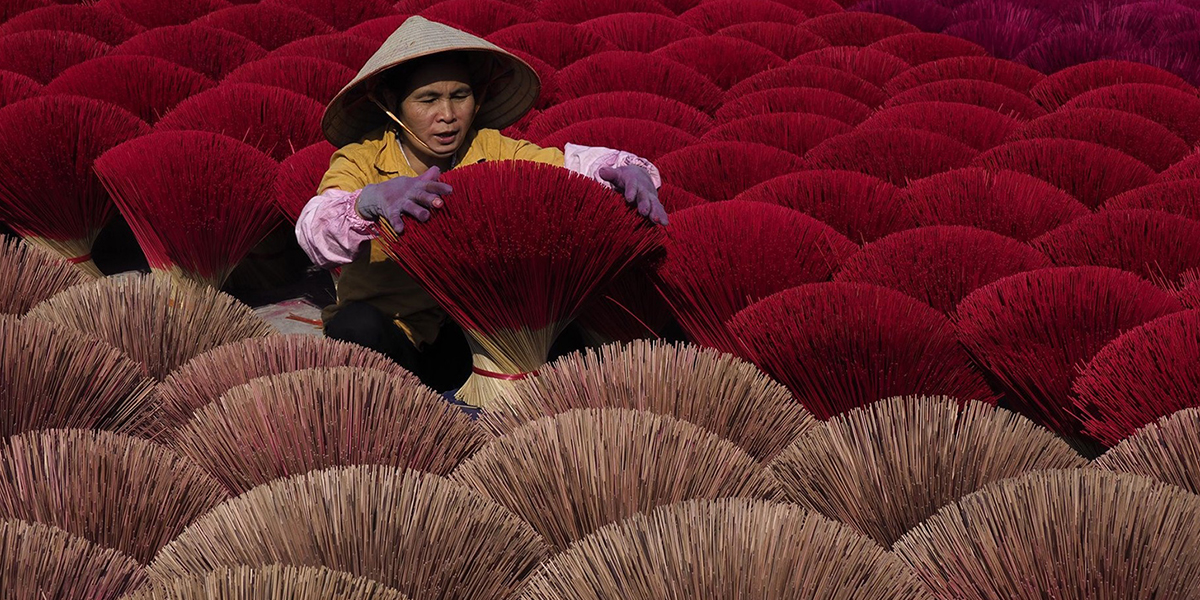This article below provides knowledge about the flags of Vietnam in terms of origin, historical meanings, its symbolication throughout the years
I - Current national flag of Vietnam
1 - History of the national flag
On November 23th 1940, it was the first time the red flag with a five - pointed yellow star appeared in the Southern uprising against French and Japanese. A year later, in May 1941, the 8th Central Communist Party Conference was held under the leadership of Ho Chi Minh. The purpose of this conference was to establish the People’s Government of the Democratic Republic of Vietnam, then proclaimed the red flag with a five - pointed yellow star in the center as the national flag of Vietnam.

Source: Internet
After that, on the second of September 1945, President Ho Chi Minh read the Independence Declaration. As a result, a red flag with five - pointed yellow stars was displayed from north to south. Then, Vietnam began the war against the US (1955 - 1975) and achieved an ending victory on April, 30th 1975. In 1976, the government of the Socialist Republic of Vietnam used this flag as the national flag until today.
2 - National flag of Vietnam meaning, symbolism, parameters & colors
Article No.13 in the Constitution of the Social Republic of Vietnam stipulates that the National Flag of the Social Republic of Vietnam formed in the shape of a rectangular with the width is two - thirds of its length, a five - pointed yellow star in the center. Vietnam’s flag is red like other communist countries; however, the red color in each country’s national flag represents different meanings depending on its own history & culture.
President Ho Chi Minh revealed the Vietnam flag color - red is the symbol for soldiers’ blood fighting for national independence. The central yellow star symbolizes Vietnamese people’s skin color and 5 points represents the integrity of 5 classes of intellectuals, peasants, workers, traders and soldiers.
Vietnam is a country suffering from many war hardships in regaining our independence; therefore, the national flag waving in the sky for peace and freedom is a sacred moment for the whole country. This flag represents a block of great unity with no longer dividing into three regions, no boundaries between communism and the republic, no classes, no hatred.
3 - When is the Vietnam national flag displayed nationally?
Travelling to Vietnam on special occasions, tourists will see a lot of red flags with a yellow star covering all corners of streets. The official flag display schedule in Vietnam includes:

Flags of Vietnam are displayed on 30/4 in Hanoi - Source: Pham Trong Tung
- New year’s eve - January 1st
- Lunar New Year - 23/12-7/1 in Lunar Calendar (from January to February in solar calendar): Lunar New Year is the most important festival in Vietnam. These days, the images of the fluttering red Vietnamese flag harmonizing with the brilliantly colorful flowers make these days in Vietnam more bustling and vibrant.
- Vietnam National Day - September 2nd
- Vietnam Reunification Day - April 30th: This day presents the ending of the Vietnam war event when the Vietnam People’s Army and the Southern Liberation Army entered Saigon. The Vietnam flags with red color are hang to show pride in Vietnam’s victory, great achievement in our national liberation path.
- International Labor day - May 1st
Note: If you have a chance to visit Hanoi, you should not miss the Flag Raising Ceremony at 6am & Flag Lowering Ceremony at 9pm in Ho Chi Minh Mausoleum.
II - Flags of Vietnam: Communist flag
Socialist Vietnam is a political institution where the Communist Party took over leadership. Immediately after the establishment of the Party on March 2nd 1930, the Communist flag or the Party flag with red background and overlapping yellow sickle and hammer image - a prominent symbol of communism representing the unity of the working class and the peasants appeared in the 1930-1931 Soviet Nghe Tinh movement.

The Communist flag Vietnam - Source: Thai Trien
You do not see many Party flags hanging freely because locals do not hang the Party flag at will, and need to follow announcements from the City People's Committee and local government. The Party flag is hung with the National Flag on holidays such as the establishment of the Party on February 3rd or the Party Congress.
III - The flags of Vietnam throughout old stages
The definition of national flags appeared in many Asian countries after the XVI century, including Vietnam. The symbol of the red flag with a yellow star is embedded in Vietnamese’s minds even though diverse flag images were introduced during the time the country was divided.
1 - Vietnam flags through some feudal dynasties
In period of 1788 - 1802: Official flag in Tay Son dynasty
The Tay Son Dynasty designed a red flag with yellow color on the outer border. This red color was chosen by three brothers of Nguyen Nhac, Nguyen Lu, Nguyen Hue during the Tay Son uprising because it represented luck. In the historical context from 1788-1802, Nguyen Hue ascended the throne, changed the national flag with a red background, yellow border and added a circle in the center.
It was explained in the feudal concept that the circle symbolized the star seen from the ground. After the interference of Western culture, the central circle was replaced by a 5-pointed star. Hence, it can be seen that today’s national flag of Vietnam is inspired by the flag in the Tay Son dynasty. .
In period of 1802 - 1885: Flag in Nguyen dynasty from king Gia Long to king Tu Duc
Long Tinh Ky (Dragon, Star, Flag) was the name of the national flag under the Nguyen dynasty, which underwent many ups and downs in its history. The flag background was colored in yellow of royalty while its border was green dragon-scale and the central circle was masculine redness.
In period of 1885 - 1890: Flag under King Dong Khanh in Nguyen dynasty
The own standard of the flag of Vietnam under King Dong Khanh was the vertical script “Dai Nam” written in Chinese letters in the middle of the yellow background - the official name of Vietnam during this time.
In period of 1890 - 1945: Long Tinh Flag, flag from King Thanh Thai to King Bao Dai in Nguyen dynasty
During the period of 1890-1920, King Thanh Thai redesigned the national flag with different details. The red color in the background symbolized the red blood while the central yellow stripe represented its royal origin as well as Vietnamese race’s skin color creating 3 stripes representing three regions of North, Central and South of Vietnam.
2 - Flags of Vietnam war
In period of 1883-1945: French Indochina Federation
Under the French government of Indochinese Federation protection, French stipulated a new national flag of the French tricolor flag on the top left corner of a yellow background, marking Vietnam as a French colonial country.
In period of 1945: Empire of Vietnam

The Vietnam flag under the Empire of Vietnam - Source: Wikipedia
The Japanese Empire implemented the coup d’état against the French colonialists, meanwhile King Bao Dai declared Independence under Japan's protection. On May 8th 1945, the Li hexagram flag - the yellow flag with one horizontal red stripe representing the Li hexagram of the Bagua eight - sign figure - was approved as the national flag. However, due to the historical happenings, in the afternoon on August 30th 1945, King Bao Dai abdicated. In fact, the Li hexagram flag in Vietnam was never adopted.
In period of 1945-1976: Democratic Republic of Vietnam
The red flag with yellow star appeared on September 2nd 1945 in the Independence Declaration Ceremony at Ba Dinh Square. On September 5th 1945, Decree No. 05 abolished the Li hexagram flag and officially defined the red flag with 5-pointed yellow star as the national flag until today.
Flags of Vietnam in period of 1946 - 1955
During the war against French from 1946 to 1954, French government desired to split Vietnam into autonomous territorial entities. In the period of 1946-1948, the Autonomous Republic of the South selected the national flag with yellow background and 3 blue stripes intersecting with 2 horizontal white stripes as the official flag of South Vietnam, representing three Southern rivers of Dong Nai, Tien Giang, Hau Giang. In the latter period 1948-1955, Thailand Autonomous Federation adopted the flag with the ratio of 2:3 of white stripes and blue ones intersecting each other and a 16-point red star attached in the center of the white stripe.
Vietnam flags In period of 1949 - 1955
On the second of June 1948, the Provisional Government of Vietnam adopted the three-red-stripe flag, symbolizing three regions of the North, Central, South in Vietnam, as the national flag and it was used even after the Vietnam National period from 1949 to 1955 and the First and Second period of Republic Vietnam 1955-1975 as well.
In period of 1969 - 1976: The South Republic of Vietnam flag of south vietnam
In 1969, the South Republic of Vietnam Government was established against the Vietnam Republic Government. The national flag was changed into 2 colors of the upper red and the lower blue with a central yellow star. This flag was used until the red flag with a 5-pointed star was officially adopted.
Note: You can easily find the red T-shirts with a yellow 5-pointed star as souvenirs around the local markets or in tourism destinations all over Vietnam with the price ranging from 100.000 to 150.000 VND/item ($ 4.31-6.47)
IV - Cultural flags of Vietnam (5-colored flag)

Source: Redsvn
It is not officially recorded about the exact time the 5-color flag first appeared. It is all based on ancient pictures of “Trung Vuong uprising” to realize the existence of this flag from the Ladies Trung period (40 - 43). A 5-color flag with squares surrounding it is the oldest traditional flag recorded in Vietnam. The five colors originated from the Eastern Law of Five Elements which contains green (wood), red (fire), yellow (earth), white (metal), purple (water).
Why is the color arrangement in 5-color Vietnam flags not the same in different Vietnamese festivals?
To explain the above question, it is based on different beliefs to select the central color and other surrounding ones depending on the Law of Five Elements. Therefore, each 5-color flag will have distinct color arrangements in each festival, temple, communal house, pagoda every year. Typical festivals are Giong Festival in Phu Dong temple - Hanoi capital, Do Son Buffalo fighting festival in Hai Phong, Bai Dinh Pagoda Festival in Ninh Binh, Hung King festival in Phu Tho, Xu Princess festival in An Giang,...
Flags of Vietnam reflecting historical events, representing all races and classes is Vietnamese’s pride and symbol of culture and history as well. Therefore, this article is hoped to provide more helpful information to Vietnamese culture under the tourists’ multidimensional perspectives.







 — Quan Nguyen
— Quan Nguyen





































